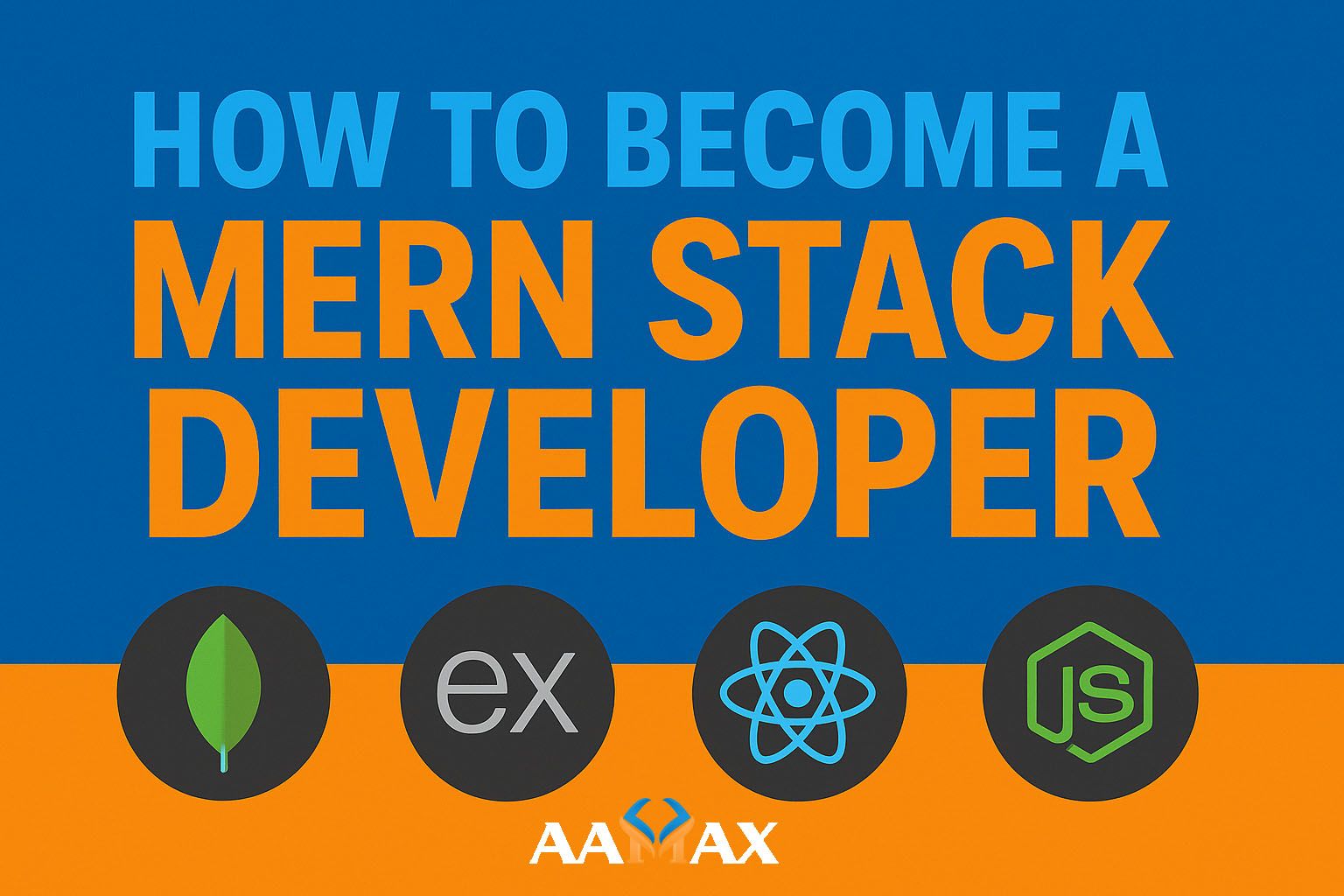
How To Become a MERN Stack Developer
In this comprehensive guide, we’ll break down how to become a MERN stack developer, the skills you need, the tools to master, and the career opportunities that await. Whether you’re a beginner or transitioning from another development field, this roadmap will help you navigate the journey effectively.
The demand for full-stack developers has skyrocketed in recent years, and among the various stacks, the MERN Stack Developer has emerged as one of the most powerful and popular. Combining MongoDB, Express.js, React, and Node.js, the MERN stack enables developers to build robust, scalable, and dynamic web applications using a single programming language — JavaScript.
What Is the MERN Stack?
Before diving into how to become a MERN developer, let’s understand what the MERN stack is.
The MERN stack is a set of technologies that work together to build full-stack web applications. It is an acronym for:
- M – MongoDB (Database)
- E – Express.js (Backend framework)
- R – React.js (Frontend library)
- N – Node.js (Runtime environment)
Each of these technologies plays a critical role in the development process:
- MongoDB: A NoSQL database that stores data in flexible JSON-like documents. It is schema-less and allows for rapid scalability.
- Express.js: A lightweight Node.js framework for building backend APIs and handling HTTP requests.
- React.js: A powerful frontend JavaScript library developed by Facebook for building dynamic, component-based user interfaces.
- Node.js: A server-side JavaScript runtime that enables developers to run JavaScript code outside the browser.
Together, these technologies allow developers to use JavaScript across the entire stack, creating a seamless and efficient development process.
Why Choose the MERN Stack?
The MERN stack is popular for a reason — it combines efficiency, scalability, and flexibility. Here are some reasons why developers and companies choose it:
-
Single Language Development:
You only need to know JavaScript to handle both frontend and backend development. -
Fast and Scalable:
With Node.js and MongoDB, the stack handles high-performance and scalable applications efficiently. -
Rich Ecosystem:
The MERN stack has a huge community, abundant resources, and libraries that simplify development. -
React for Frontend:
React’s component-based architecture allows for reusable UI components and fast rendering. -
JSON Everywhere:
Both MongoDB and Express.js use JSON, ensuring seamless data flow between client and server. -
Open Source Tools:
All components of the MERN stack are open source, making them cost-effective and easy to adopt.
Step-by-Step Roadmap to Becoming a MERN Stack Developer
Becoming a proficient MERN developer involves mastering several layers of web development — from frontend to backend, databases, and deployment. Let’s break it down step by step.
Step 1: Learn the Fundamentals of Web Development
Before diving into the MERN stack, you must have a solid understanding of web development basics:
- HTML: Learn how to structure webpages using semantic HTML.
- CSS: Understand how to style and layout your content using CSS and responsive design.
- JavaScript: Master the fundamentals of JavaScript including ES6+ features like arrow functions, destructuring, promises, async/await, and modules.
Key concepts to focus on:
- DOM manipulation
- Event handling
- Fetch API and AJAX
- JSON and data exchange between frontend and backend
Step 2: Master JavaScript and ES6+
Since JavaScript is the core of the MERN stack, you need to be proficient in modern JavaScript syntax and best practices.
Topics to cover:
- ES6+ syntax (let, const, arrow functions, spread/rest operators)
- Object-oriented programming in JS
- Functional programming concepts
- Modules and imports/exports
- Error handling and debugging
Having a strong command of JavaScript will make it much easier to transition into frameworks and backend technologies.
Step 3: Learn React.js for Frontend Development
React.js is the "R" in MERN and is responsible for building dynamic, responsive, and high-performance user interfaces.
Core concepts to learn:
- Components and JSX
- State and Props
- Hooks (useState, useEffect, useContext, etc.)
- React Router for navigation
- Context API or Redux for state management
- Handling forms and user inputs
- API integration using fetch or Axios
Project idea:
Create a simple To-Do App or Weather App using React to practice component-based design and state management.
Step 4: Learn Node.js and Express.js for Backend Development
Once you’re comfortable with the frontend, it’s time to move to the backend with Node.js and Express.js.
- Node.js: Learn how to run JavaScript on the server, manage dependencies with npm, and create APIs.
- Express.js: A minimalistic web framework that simplifies route handling, middleware integration, and server setup.
Key topics:
- Creating RESTful APIs
- Middleware functions
- Routing and controllers
- Error handling
- Authentication and authorization (JWT)
- Connecting with databases
Project idea:
Build a simple REST API for managing users or tasks, using Express and Node.js.
Step 5: Learn MongoDB for Database Management
MongoDB is a NoSQL database that uses documents rather than traditional tables. It’s highly scalable and integrates perfectly with Node.js.
Key concepts:
- Collections and documents
- CRUD operations (Create, Read, Update, Delete)
- Mongoose ORM
- Data validation and schema design
- Indexing and query optimization
Project idea:
Integrate MongoDB into your Node.js app to store user data, posts, or products.
Step 6: Connecting the Dots — Full-Stack Integration
Once you’ve learned all four components of the MERN stack, it’s time to combine them into a full-stack project.
Integration flow:
- Frontend (React) communicates with the backend (Express/Node) via API calls.
- Backend interacts with the MongoDB database to retrieve or modify data.
- The entire application is connected seamlessly using RESTful APIs and JSON.
Project idea:
Build a complete MERN Stack Blog App where users can sign up, post articles, and comment — integrating frontend, backend, and database layers.
Step 7: Version Control with Git and GitHub
Version control is crucial for managing code, especially in team environments.
Learn to:
- Initialize and manage repositories with Git
- Commit and push changes
- Create branches and pull requests
- Collaborate using GitHub or GitLab
These skills are essential when working on professional projects or contributing to open source.
Step 8: Learn Deployment and DevOps Basics
A complete MERN developer should also know how to deploy and maintain applications.
Tools and platforms to explore:
- Hosting: Vercel, Netlify (for frontend), and Render, AWS, or DigitalOcean (for backend)
- Database hosting: MongoDB Atlas
- CI/CD: GitHub Actions or Jenkins for automated deployment
- Environment variables: Using
.envfor managing sensitive data
Deploying your project is the final step in bringing your application to life and showcasing your skills to potential employers or clients.
Step 9: Build Real-World Projects
Practical experience trumps theory. As you master the stack, focus on building real-world, scalable applications that solve problems.
Examples:
- E-commerce platform
- Social media dashboard
- Real-time chat application
- Task management system
- Job portal or freelance marketplace
Each project helps you refine your understanding of architecture, data flow, and performance optimization.
Step 10: Stay Updated and Join the Community
Technology evolves fast — especially JavaScript frameworks. Stay updated with the latest versions, libraries, and tools by:
- Following official documentation
- Joining communities on Reddit, Discord, or Stack Overflow
- Reading blogs and watching tutorials
- Contributing to open source projects
Continuous learning is key to staying competitive in the MERN ecosystem.
Essential Tools for MERN Developers
Here are some tools every MERN developer should be comfortable with:
- Visual Studio Code: Lightweight and powerful code editor.
- Postman: For testing APIs.
- MongoDB Compass: GUI for MongoDB databases.
- Git & GitHub: For version control and collaboration.
- Browser DevTools: For debugging frontend code.
- npm/yarn: For managing dependencies and packages.
Career Opportunities for MERN Developers
The MERN stack offers diverse career paths due to its versatility. You can pursue roles such as:
- Frontend Developer (React.js)
- Backend Developer (Node.js/Express.js)
- Full-Stack Developer (MERN)
- Web Application Developer
- Software Engineer
Average salary range:
MERN stack developers are highly valued, with global salaries ranging from $60,000 to $120,000+ depending on experience and location.
How AAMAX Can Help You Build MERN Stack Solutions
If you’re a business looking to build high-performance web applications, hiring an expert development team can save you time and ensure scalability.
AAMAX is a full-service digital marketing and web development company specializing in MERN stack development, SEO, and digital marketing. Their experienced developers craft powerful, responsive, and secure applications tailored to your business goals.
Whether you need a dynamic e-commerce platform, SaaS application, or enterprise-grade web solution — hire AAMAX for professional MERN stack services that deliver measurable results.
Final Thoughts
Becoming a MERN stack developer requires dedication, consistency, and hands-on experience. By mastering JavaScript and its ecosystem, you open doors to exciting opportunities in full-stack development. Start small, build progressively complex projects, and stay curious — that’s the roadmap to success.
With the right skills and the right mindset, you can build modern, scalable, and high-performing applications that stand out in today’s digital landscape.







